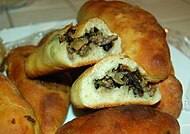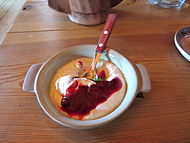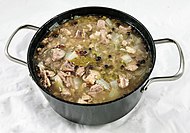European cuisine



European cuisine comprises the cuisines of Europe[1] [2] including the cuisines brought to other countries by European settlers and colonists. Sometimes the term "European", or more specifically "continental" cuisine, is used to refer more strictly to the cuisine of the western parts of mainland Europe.


The cuisines of Western countries are diverse, although there are common characteristics that distinguish them from those of other regions.[3] Compared with traditional cooking of East Asia, meat is more prominent and substantial in serving size.[4] Steak and cutlets in particular are common dishes across the West.[dubious ] Western cuisines also emphasize grape wine[dubious ] and sauces as condiments, seasonings, or accompaniments (in part due to the difficulty of seasonings penetrating the often larger pieces of meat used in Western cooking). Many dairy products are utilised in cooking.[5] There are hundreds of varieties of cheese and other fermented milk products. White wheat-flour bread has long been the prestige starch, but historically, most people ate bread, flatcakes, or porridge made from rye, spelt, barley, and oats.[6][7] The better-off also made pasta, dumplings and pastries. The potato has become a major starch plant in the diet of Europeans and their diaspora since the European colonisation of the Americas. Maize is much less common in most European diets than it is in the Americas; however, corn meal (polenta or mămăligă) is a major part of the cuisine of Italy and the Balkans. Although flatbreads (especially with toppings such as pizza or tarte flambée) and rice are eaten in Europe, they are only staple foods in limited areas, particularly in Southern Europe. Salads (cold dishes with uncooked or cooked vegetables, sometimes with a dressing) are an integral part of European cuisine.
Formal European dinners are served in distinct courses. European presentation evolved from service à la française, or bringing multiple dishes to the table at once, into service à la russe, where dishes are presented sequentially. Usually, cold, hot and savoury, and sweet dishes are served strictly separately in this order, as hors d'oeuvre (appetizer) or soup, as entrée and main course, and as dessert. Dishes that are both sweet and savoury were common earlier in Ancient Roman cuisine, but are today uncommon, with sweet dishes being served only as dessert. A service where the guests are free to take food by themselves is termed a buffet, and is usually restricted to parties or holidays. Nevertheless, guests are expected to follow the same pattern.
Historically, European cuisine has been developed in the European royal and noble courts. European nobility was usually arms-bearing and lived in separate manors in the countryside. The knife was the primary eating implement (cutlery), and eating steaks and other foods that require cutting followed. This contrasted with the Sinosphere, where the ruling class were the court officials, who had their food prepared ready to eat in the kitchen, to be eaten with chopsticks. The knife was supplanted by the spoon for soups, while the fork was introduced later in the early modern period, ca. 16th century. Today, most dishes are intended to be eaten with cutlery and only a few finger foods can be eaten with the hands in polite company.
History[]
This section needs expansion. You can help by . (September 2020) |
Medieval[]
Early modern era[]
In the early modern era, European cuisine saw an influx of new ingredients due to the Columbian Exchange, such as the potato, tomato, eggplant, chocolate, bell pepper, and pumpkins and other squash. Distilled spirits, along with tea, coffee, and chocolate were all popularized during this time. In the 1780s, the idea of the modern restaurant was introduced in Paris; the French Revolution accelerated its development, quickly spreading around Europe.
Central European cuisines[]
All of these countries have their specialities.[8] Austria is famous for Wiener Schnitzel - a breaded veal cutlet served with a slice of lemon, the Czech Republic for world renowned beers. Germany for world-famous wursts, Hungary for goulash. Slovakia is famous for gnocchi-like Halusky pasta. Slovenia is known for German and Italian influenced cuisine, Poland for world-famous Pierogis which are a cross between a ravioli and an empanada. Liechtenstein and German speaking Switzerland are famous for Rösti and French speaking Switzerland for fondue and Raclettes.
- Ashkenazi Jewish cuisine
 Austrian cuisine
Austrian cuisine
 Viennese cuisine
Viennese cuisine
 Czech cuisine
Czech cuisine German cuisine
German cuisine
- Baden cuisine
 Bavarian cuisine
Bavarian cuisine Brandenburg cuisine
Brandenburg cuisine Franconian cuisine
Franconian cuisine Hamburg cuisine
Hamburg cuisine Hessian cuisine
Hessian cuisine Lower Saxon cuisine
Lower Saxon cuisine Mecklenburg cuisine
Mecklenburg cuisine- Palatine cuisine
- Pomeranian cuisine
 Saxon cuisine
Saxon cuisine
 Schleswig-Holstein cuisine
Schleswig-Holstein cuisine- Swabian cuisine
 Hungarian cuisine
Hungarian cuisine Polish cuisine
Polish cuisine
 Liechtensteiner cuisine
Liechtensteiner cuisine Silesian cuisine
Silesian cuisine Slovak cuisine
Slovak cuisine Slovenian cuisine
Slovenian cuisine Swiss cuisine
Swiss cuisine
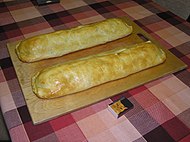
Austrian strudel
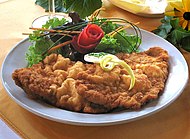
Austrian Wiener Schnitzel
Czech Svíčková

German Currywurst
German pretzel
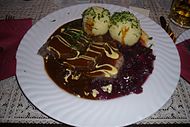
German Sauerbraten

Hungarian goulash

Polish bagel

Polish pierogi
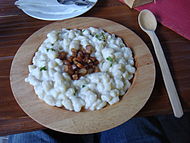
Slovakian Bryndzové halušky
Slovakian Skalický trdelník

Slovenian Idrijski žlikrofi
Slovenian Prekmurska gibanica

Swiss fondue
Eastern European/Caucasian cuisines[]
 Armenian cuisine
Armenian cuisine Azerbaijani cuisine
Azerbaijani cuisine Belarusian cuisine
Belarusian cuisine Georgian cuisine
Georgian cuisine Kazakh cuisine
Kazakh cuisine Moldovan cuisine
Moldovan cuisine
 Romanian cuisine
Romanian cuisine Russian cuisine
Russian cuisine
 Bashkir cuisine
Bashkir cuisine Komi cuisine
Komi cuisine Mordovian cuisine
Mordovian cuisine North Caucasian cuisine
North Caucasian cuisine
 Chechen cuisine
Chechen cuisine Circassian cuisine
Circassian cuisine
 Tatar cuisine
Tatar cuisine Udmurt cuisine
Udmurt cuisine- Yamal cuisine
 Ukrainian cuisine
Ukrainian cuisine
 Crimean Tatar cuisine
Crimean Tatar cuisine Odessite cuisine
Odessite cuisine

Armenian khorovats

Azerbaijani piti

Bashkir and Tatar Öçpoçmaq
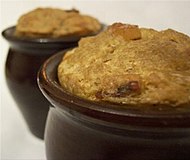
Belarusian potato babka

Bulgarian banitsa

Bulgarian Garash cake
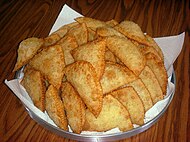
Circassian Haliva

Crimean Tatar chiburekki

Georgian khachapuri
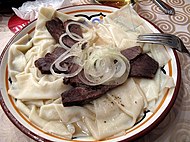
Kazakh beshbarmak

Moldovan Tochitură
Romanian Cocoloși
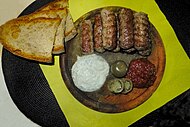
Romanian mititei

Russian beef Stroganoff
Russian pirozhki
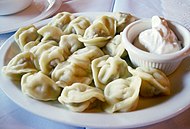
Russian pelmeni

Ukrainian borscht

Ukrainian pampushka
Northern European cuisines[]
 Danish cuisine
Danish cuisine
 Estonian cuisine
Estonian cuisine Faroese cuisine
Faroese cuisine Finnish cuisine
Finnish cuisine Icelandic cuisine
Icelandic cuisine Latvian cuisine
Latvian cuisine Lithuanian cuisine
Lithuanian cuisine Livonian cuisine
Livonian cuisine Norwegian cuisine
Norwegian cuisine Sami cuisine
Sami cuisine Swedish cuisine
Swedish cuisine
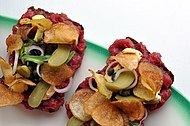
Danish smørrebrød

Danish stegt flæsk
Estonian kama dessert
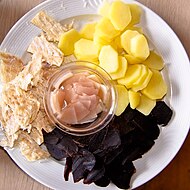
Faroese tvøst og spik
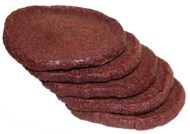
Finnish blodplättar
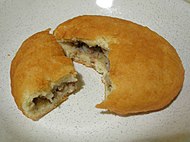
Finnish lihapiirakka

Finnish viili
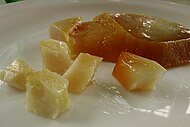
Icelandic Hákarl

Latvian layered rye bread
Lithuanian cepelinai

Livonian Sklandrausis
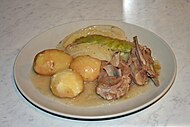
Norwegian fårikål

Norwegian lutefisk
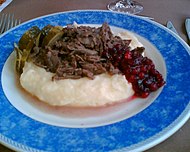
Sami Sautéed reindeer
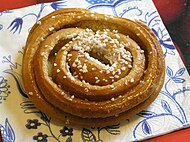
Swedish cinnamon roll
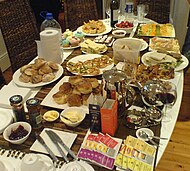
Swedish smörgåsbord
Swedish surströmming
Southern European cuisines[]
 Albanian cuisine
Albanian cuisine Basque cuisine
Basque cuisine Bosnian cuisine
Bosnian cuisine Bulgarian cuisine
Bulgarian cuisine Byzantine cuisine
Byzantine cuisine
 Catalan cuisine
Catalan cuisine Croatian cuisine
Croatian cuisine Cypriot cuisine
Cypriot cuisine Gibraltarian cuisine
Gibraltarian cuisine Greek cuisine
Greek cuisine
- Ancient Greek cuisine
 Cretan cuisine
Cretan cuisine- Epirotic cuisine
 Greek Macedonian cuisine
Greek Macedonian cuisine Ionian cuisine
Ionian cuisine
 Italian cuisine
Italian cuisine
 Abruzzian cuisine
Abruzzian cuisine- Ancient Roman cuisine
 Apulian cuisine
Apulian cuisine- Arbëreshë cuisine
 Ligurian cuisine
Ligurian cuisine Lombard cuisine
Lombard cuisine Neapolitan cuisine
Neapolitan cuisine Roman cuisine
Roman cuisine Sardinian cuisine
Sardinian cuisine Sicilian cuisine
Sicilian cuisine Venetian cuisine
Venetian cuisine
 Macedonian cuisine
Macedonian cuisine Maltese cuisine
Maltese cuisine Montenegrin cuisine
Montenegrin cuisine Ottoman cuisine
Ottoman cuisine Portuguese cuisine
Portuguese cuisine Sammarinese cuisine
Sammarinese cuisine- Sephardic Jewish cuisine
 Serbian cuisine
Serbian cuisine
 Kosovan cuisine
Kosovan cuisine
 Spanish cuisine
Spanish cuisine
 Andalusian cuisine
Andalusian cuisine Aragonese cuisine
Aragonese cuisine Asturian cuisine
Asturian cuisine Balearic cuisine
Balearic cuisine
 Canarian cuisine
Canarian cuisine Cantabrian cuisine
Cantabrian cuisine Castilian-Leonese cuisine
Castilian-Leonese cuisine
 Castilian-Manchego cuisine
Castilian-Manchego cuisine Extremaduran cuisine
Extremaduran cuisine Galician cuisine
Galician cuisine Madrilenian cuisine
Madrilenian cuisine Valencian cuisine
Valencian cuisine
 Turkish cuisine
Turkish cuisine

Albanian Tavë kosi

Andalusian gazpacho

Balearic ensaïmada
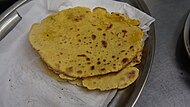
Basque talo

Bosnian ćevapi

Catalan pa amb tomàquet

Cretan Dakos

Croatian Zagorski štrukli
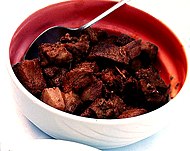
Cypriot Afelia
Greek gyros
Greek souvlaki

Greek spanakopita
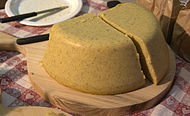
Italian polenta

Italian ravioli

Italian spaghetti

Kosovan flia

Lombard risotto

Macedonian Tavče gravče

Madrilenian squid sandwich

Maltese rabbit stew

Montenegrin njeguški pršut

Neapolitan pizza
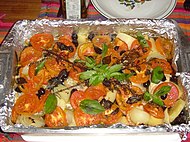
Portuguese bacalhau
Portuguese Cozido à portuguesa

Roman Carciofi alla Romana

Sammarinese Bustrengo
Serbian Pljeskavica

Sicilian cannoli
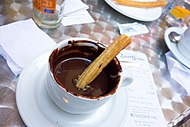
Spanish churro

Spanish omelette
Spanish tapas
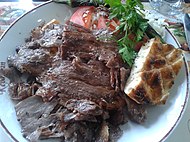
Turkish doner kebab

Turkish macun

Valencian paella
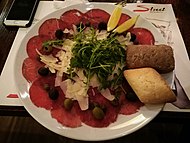
Venetian carpaccio
Western European cuisines[]
 Belgian cuisine
Belgian cuisine British cuisine
British cuisine
 English cuisine
English cuisine
 Cornish cuisine
Cornish cuisine Devonian cuisine
Devonian cuisine Dorset cuisine
Dorset cuisine- Victorian cuisine
- Northern Irish cuisine
 Scottish cuisine
Scottish cuisine Welsh cuisine
Welsh cuisine
 Dutch cuisine
Dutch cuisine French cuisine
French cuisine
 Corsican cuisine
Corsican cuisine- Haute cuisine
- Cuisine classique
- Nouvelle cuisine
 Lyonnaise cuisine
Lyonnaise cuisine
 Irish cuisine
Irish cuisine Luxembourgian cuisine
Luxembourgian cuisine- Mennonite cuisine
 Monégasque cuisine
Monégasque cuisine Occitan cuisine
Occitan cuisine

Belgian Boulets à la Liégeoise

Belgian moules-frites

Belgian waffle

British bangers and mash
British full breakfast
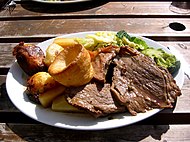
British Sunday roast
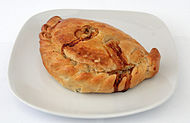
Cornish pasty

Corsican fritelli
Dutch kibbeling
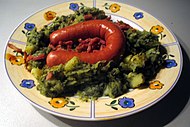
Dutch stamppot with rookworst
English Christmas pudding

English fish and chips

English shepherd's pie

French escargot

French pot-au-feu

French quiche

Irish breakfast roll

Irish stew

Luxembourgian Judd mat Gaardebounen
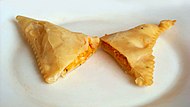
Monégasque Barbajuan

Northern Irish pastie supper

Occitan aligot

Scottish haggis
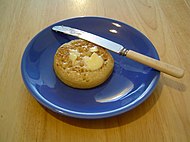
Welsh crumpet
See also[]
- Early modern European cuisine
- Medieval cuisine
- Jewish cuisine
- Romani cuisine
References[]
- ^ Culinary Cultures of Europe: Identity, Diversity and Dialogue. Council of Europe.
- ^ "European Cuisine." Europeword.com Archived 2017-10-09 at the Wayback Machine. Accessed July 2011.
- ^ Kwan Shuk-yan (1988). Selected Occidental Cookeries and Delicacies, p. 23. Hong Kong: Food Paradise Pub. Co.
- ^ Lin Ch'ing (1977). First Steps to European Cooking, p. 5. Hong Kong: Wan Li Pub. Co.
- ^ Kwan Shuk-yan, pg 26
- ^ Alfio Cortonesi, "Self-sufficiency and the Market: Rural and Urban Diet in the Middle Ages", in Jean-Louis Flandrin, Massimo Montanari, Food: A Culinary History from Antiquity to the Present, 1999, ISBN 0231111541, p. 268ff
- ^ Michel Morineau, "Growing without Knowing Why: Production, Demographics, and Diet", in Jean-Louis Flandrin, Massimo Montanari, Food: A Culinary History from Antiquity to the Present, 1999, ISBN 0231111541, p. 380ff
- ^ "Cuisine from Central Europe". Visit Europe. Archived from the original on 23 August 2012. Retrieved 1 July 2013.
Further reading[]
- Albala, Ken (2003). Food in Early Modern Europe. Greenwood Publishing Group. ISBN 0313319626. Retrieved 6 June 2017.
- R & R Publishing (2005). European Cuisine: The Best in European Food. Cpg Incorporated. ISBN 1740225279. Retrieved 6 June 2017.
- European cuisine
- Food- and drink-related lists
- Cuisine by continent




























